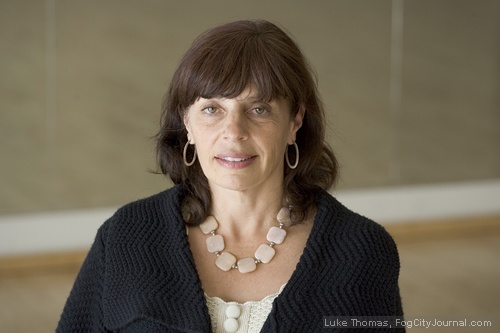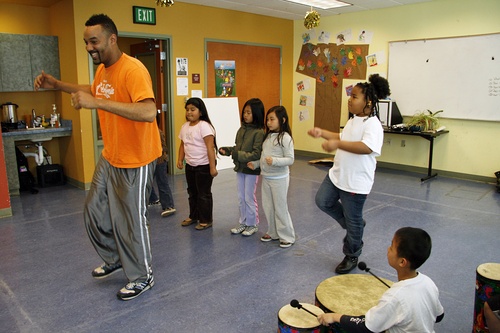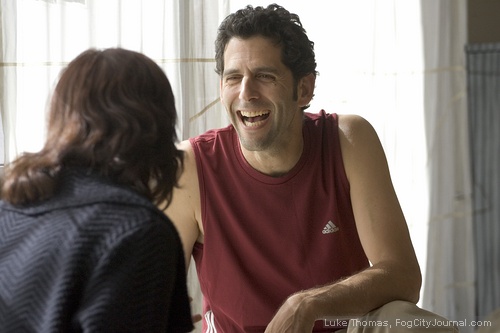
Lisa Moresco
Photo by Luke Thomas
By Lisa Moresco
May 13, 2008
With dance, they say, you can make romance, you can feed the soul, and you can even show-up your partner by gliding through all your steps backwards in a tight-fitting ball gown on high heels.
But can you change the future of disadvantaged youth? Can you join together branches of art, such as dance, movement, and improv-theatre skills to help heal and educate a community of at-risk youth?
Since 1965, thousands of San Francisco’s under-served youth have benefited from one highly-trained dancer’s vision to bring her skills and teaching talents to neighborhoods with little resources for arts education.

Dance instructor Jason Brown provides at-risk youth
in Visitacion Valley dance and music instruction.
Photo courtesy Performing Arts Workshop
Gloria Unti started at the Telegraph Hill Community Center creating a program for street-savvy at-risk teens to explore the creative process of dance and improv-theater. Her vehicle for expanding her work became the highly successful and well-regarded Performing Arts Workshop (PAW) that serves at-risk youth citywide through its Artists-In-School and Artists-In-Community Programs.
PAW celebrates 43-years of providing quality arts education throughout the Bay Area with The Mighty Fair, a fundraiser at the Mighty Galleries on Wednesday, May 14th.
PAW Board President since 2005, Peter Rothblatt, a dancer, dance instructor, and massage therapist, joins me in discussion.

PAW Board President Peter Rothblatt.
FCJ: How did you get involved with PAW?
Rothblatt: I moved to SF in’87 to pursue my career in modern dance. I knew I would need to supplement my income and wanted to do that by teaching, which is what I trained to do in college. Though I don’t remember how I found The Workshop, the fit between the PAW, their Artist-In-Schools program and my desire dovetailed very well. Then I met Gloria. She is a very compelling person with a compelling vision, and she walks her talk.
She really believes in the power of art and reflection to help kids transform their lives.
After teaching for ten years, I took a break. Three years ago, Tom DeCaigny, the Workshop’s Executive Director, called and invited me to apply to join the Board.
FCJ: What skills are the artists-in-residence trying to cultivate?
Rothblatt: We teach pre-k through grade twelve so there are different skills at different levels. On the younger side, we are teaching gross and fine motor skills. And we’re also trying to cultivate increased cooperation and participation.
FCJ: What do you mean by participation?
Rothblatt: I mean being able to both engage in activity and reflectively observe other students “performing” their skills – teaching kids to really look at what someone is producing or presenting and teaching them to describe what they see.
FCJ: The beginning of critical thinking…
We are constantly trying to engage the critical thinking process. With little kids it starts with the questions “What did you see?” and “How can we make what you saw more aesthetic and dynamic?” As we work with older students, we take those rudimentary questions into a full critical thinking process.
FCJ: What types of dance and other artistic education are coupled with the cognitive learning?
Rothblatt: We offer creative movement, theatre arts, creative writing, many world dance and world music forms and choral work residencies.
FCJ: Tell me about the evolution of the Workshop from working with teens to this year’s third cycle providing workshops for the Preschool for All Program.
Rothblatt: Gloria started working in the Telegraph Hill Community Center; she really talks about it in ways that would be considered gang intervention. At the beginning of a session, she would connect with the youth leaders who would bring their friends and then she would work with them in movement and theatre to identify their concerns and perspectives and help them shape their material into performances that used satire and made a social critique She gave them an opportunity and a voice to express their sense of the world and their place in it.
The work with younger kids began in ’74 when Gloria expanded into in-school settings.
Today, our Artists-in-Schools Program constitutes the lion share of direct service. At the same time, we are very engaged in our Artist-in-Community program because it allows us to work with youth and teens that might not have contact with our Artist-in-Schools Program.
FCJ: And where do the Artists-In-Community Programs take place?
Rothblatt: We teach in homeless shelters, in community centers, in community court schools and in after-school programs, to name a few. It is in these settings that arts education starts to connect with the broader issue of Youth Development.
FCJ: PAW has been able to document through a recent study funded by U.S. Dept of Education that art instruction works to build self-esteem and improve performance in other areas of education. Beyond scientific evidence validating your work and vision how has the study affected the PAW?
Rothblatt: It helped us be more effective in our program design – for example, how to have a more productive collaboration with the classroom teacher. It also showed us that the intensity of the residency is a strong indicator of the successful outcomes for kids. I mean, when we have 8-week programs, we have much less impact than when we have 20-32 week programs. The deeper the service we provide, the more able we are to provide sequentially based learning and have a more lasting effect with the kids. It’s an obvious lesson and is particularly relevant to our mission which stresses the use of the arts to meet larger educational and developmental goals.
The Department of Education research also contributed to our ideas regarding our internal training process – how we train our teaching artists to use our methodology. The changes we’ve implemented in that regard have had a very positive effect on the organization’s work.
FCJ: Now more than ever, our society survives on volunteerism. Our churches encourage us, our schools plead with us, the federal government hopes to motivate us, even Mayor Newsom created the Project Homeless Connect and asked SF citizens to step up and become involved. And we respond, we volunteer in huge numbers because after all, it really is good for the soul, isn’t it?
Rothblatt: Before I joined the Board last year, I was looking for some way to make an impact bigger than I could in my work as a massage therapist. At the same time, I wanted it to be 100% service – no pay. And I wanted both of these because my values – my spiritual practice – lead me to want to help make the world a better place. A Grandiose vision with local execution. And doing that in the context of volunteering gives me a purity of intent. I’m not doing it to make money or gain status. I do it to help me connect with others, with strangers, with “outsiders” – and to maybe push us every slightly toward a brighter future. So it really is soul work for me.
The Mighty Fair, a fundraiser for the Performing Arts Workshop, is being held Wednesday, May 14th at Mighty Galleries, 119 Utah Street from 7 to 10 pm.


 The Hunger Site
The Hunger Site
No Comments
Comments for Performing Arts Workshop Targets At-Risk Youth are now closed.